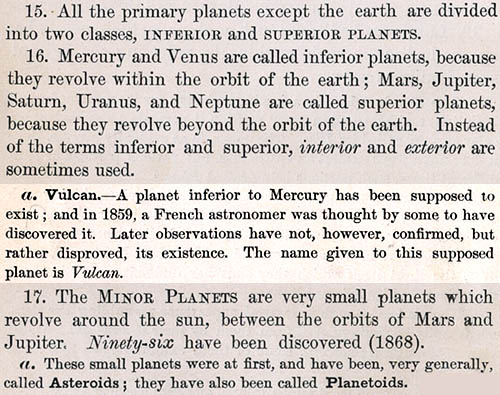Planet Vulcan
Today, I discover a new planet. The University of Houston's College of Engineering presents this series about the machines that make our civilization run, and the people whose ingenuity created them.
So I'm thumbing through the 1876 volume of The Manufacturer and Builder, a magazine for mechanical generalists. Articles tell about industrial machinery, house designs, mathematical puzzles, musical instruments. Then I find a fascinating little notice. The header says, The New Planet Vulcan.
The What!
Star Trek didn't appear until ninety years later. So I read: The article begins: "Our text-books on astronomy will have to be revised again, as there is no longer any doubt about the existence of a planet between Mercury and the sun." It goes on to describe the small planet Vulcan, and it tells of several sightings -- all made after 1859, when French astronomer Urbain Jean Joseph Le Verrier predicted its existence.
Next, I hasten to the Internet where I find, to my chagrin, that I seem to be the only kid on the block who doesn't know about Vulcan. Many people still believe that there's a planet inside Mercury's orbit. Alchemy websites celebrate it. I find one that says it exists in an alternate universe.

Le Verrier was the same astronomer who, by studying orbital anomalies, correctly predicted the existence of Neptune, in 1846. After that he set out to do a grand study of planetary orbits, correcting and fixing all of the errors and anomalies. Then he came to Mercury's orbit. It shifted slightly after each turn about the sun, and Newtonian mechanics failed to account for its behavior. He finally announced that there must be another planet, maybe a cluster of small planets, inside Mercury's orbit.
Much later, Einstein's relativity theory correctly explained Mercury's orbit. The immense gravity of the sun actually bent space locally. Newton's laws were helpless to explain that, and Le Verrier still lived in a fully Newtonian world. Another orbiting mass, another planet, had to be disturbing Mercury's movement. Baum's and Sheehan's book on Vulcan tells its whole story in the title: In Search of Planet Vulcan: The Ghost in Newton's Clockwork Universe.
Le Verrier was far more cautious about his ghost planet than many of the people who looked for it. Sightings were a lot like those of the Loch Ness reptile -- a glint of light next to the sun, a small moving sunspot. Many who looked where the ghost should've been, couldn't find it. The sighting that triggered my article came from a German astronomer in China. (Le Verrier himself, angry with the Germans for having destroyed his observatory during the Franco-Prussian War, wanted no part of a German verification.)
In any case, Vulcan was not easy to let go of, even after Einstein -- as hard to let go of as Newtonian physics, I suppose. So we now place our Vulcan out on a far wing of the Milky Way. There is the green home-world of Mr. Spock - At least one being who won't let his scientific vision be clouded by hopes, dreams, and expectations.
I'm John Lienhard, at the University of Houston, where we're interested in the way inventive minds work.
The New Planet Vulcan. The Manufacturer and Builder, Vol. Eight, Nov. 1876, pg. 255.
J. R. Lévy, Le Verrier, Urbain Jean Joseph, Dictionary of Scientific Biography. Vol. VIII (C.C. Gilespie, ed.) New York: Chas. Scribner's Sons, 1973.
R. Baum, and W. Sheehan, In Search of Planet Vulcan: The Ghost in Newton's Clockwork Universe. New York: Plenum Trade, 1997.
The text below is how Vulcan was being dealt with in 1873. This is from H. Kiddle, A New Manual of the Elements of Astronomy. New York:Ivison, Blakeman, Taylor, & Company, 1873. For Kiddle's description of the entire solar system at that time, CLICK HERE. (Note that he does not yet include Pluto.)
